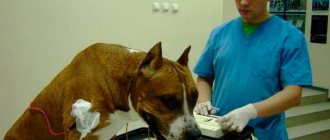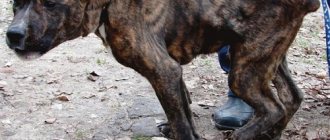Liver disease in dogs is very dangerous. They begin almost asymptomatically, the first signs are similar to simple malaise or fatigue. If your pet's behavior is different from usual, and his health causes you concern, consult a doctor. A dog can't pretend. If she feels bad, it means that something is wrong with her body. Only timely treatment of any disease can be successful.
What liver diseases can a dog have?
There are many liver diseases; they may be similar in symptoms, but differ in their cause, further development and method of treatment.
The most common:
- infectious diseases (leptospirosis, viral hepatitis and others);
- toxic diseases that manifest themselves in liver failure (poisoning with poor-quality food, medications, toxic chemicals);
- helminthic infestations;
- tumors;
- cirrhosis of the liver.
Liver failure is divided into two types:
- Acute – appears suddenly, symptoms usually appear immediately and quickly intensify. The cause may be poisoning or infection.
- Chronic – poor health is noticeable when the disease is advanced. Due to prolonged disruption of the liver, slow intoxication of the body occurs. The reasons are different: low-quality food, the daily consumption of which slowly poisons the body; uncontrolled self-medication with medications for a long time; parasite infection; slow growth of tumors; cirrhosis and many other reasons.
Some dogs have a pathology called true liver failure. For some reason, the blood does not pass through the liver for cleansing, and carries toxins throughout the body. At the same time, the liver is completely healthy.
Classification of types of pathology
Liver failure in dogs can have endogenous (internal) or exogenous (external) causes.
Endogenous liver failure
Exogenous liver failure is relative. The pathology is associated with impaired hepatic blood flow, despite the fact that the liver itself is healthy.
With exogenous deficiency, the body is poisoned to a greater extent by ammonia, which is not converted by the liver into urea, accumulating in the body and having a detrimental effect on the brain. Therefore, the disease has another name - hepatic encephalopathy.
Symptoms
Liver disease in dogs at an early stage is almost invisible. Possible liver problems may be indicated by:
- lethargy, weakness, apathy;
- lack of appetite;
- weight loss;
- thirst.
If you notice such ailments in your pet, and they do not go away for several days, then you need to consult a doctor to clarify the cause and determine the diagnosis.
It is better to rule out liver disease than to start it. Liver failure leads to the death of the animal.
With extensive liver damage, the dog’s condition becomes noticeably worse. Can appear:
- nausea, vomiting;
- diarrhea, which may alternate with constipation;
- stool is light in color, closer to gray;
- flatulence;
- bright yellow urine, sometimes orange or brownish in color;
- abdominal pain;
- an enlarged liver can be felt in the right hypochondrium;
- dry, flaky skin with a yellowish tint;
- dry mucous membranes;
- temperature increase;
- disturbance in behavior (the dog can become aggressive, or vice versa – affectionate and docile, performs actions that are not characteristic of it in a healthy state);
- ascites - dropsy of the abdominal cavity. Outwardly, this manifests itself in the fact that the stomach swells and hangs lower than usual. If you lift a dog by its front paws, its body is shaped like a pear.
In severe cases of the disease, the dog may lose vision and sense of smell. Her movements become uncertain, coordination is impaired. Mental disturbances may occur.
Prevention measures
Vaccinate your dog annually to prevent infection with infectious diseases.
Monitor her diet and feed only special foods that are balanced in composition. If you are overweight, put your dog on a diet to avoid obesity.
Be attentive to all changes in your dog’s behavior and contact your veterinarian in a timely manner, as a timely diagnosis greatly increases the likelihood of recovery.
Let your dog be healthy and energetic for many years to come!
Diagnostics
An accurate diagnosis and cause of the disease can only be established after a complete examination. It includes:
- blood chemistry;
- urine and stool analysis;
- ultrasonography;
- biopsy.
A blood test shows whether there is an inflammatory process, anemia, or the level of blood clotting. In addition, the amount of various enzymes produced by the liver is determined. If they are higher or lower than normal, this indicates which liver function is impaired.
When performing an ultrasound, infectious diseases, neoplasms, parasite infection, cirrhosis, hepatitis are detected:
- if liver damage is caused by infection, then ultrasound examination can detect dense areas with calcium salts;
- in the presence of a neoplasm, a heterogeneous structure without clear boundaries is visible, blood, pus or bile can be found inside the tumor, the vessels around the tumor are deformed;
- if the liver is damaged by parasites, then various spots are visible on it;
- with cirrhosis, the structure of the liver is changed, similar to a mosaic with denser areas, the edges and corners are widened. If cirrhosis is diagnosed at an early stage, the liver may become enlarged. In a neglected state - greatly reduced.
- with any type of hepatitis, the liver is enlarged, has areas of heterogeneous density, and the vessels are not clearly visible.
The combination of all studies: ultrasound, blood tests, urine, feces and clinical manifestations allow us to establish an accurate diagnosis, the degree of liver dysfunction and the condition of the dog’s entire body. Only then can the veterinarian prescribe treatment.
Unfortunately, in some cases, the disease is in an advanced state, the liver is so damaged that it is impossible to restore its functions. At the same time, the dog experiences pain and suffering. Due to the fact that it is impossible to improve this condition of the animal, the surest way would be to euthanize it.
Diagnosis and treatment of a pet
Hepatozoonosis, encephalopathy and other liver diseases are not so easy to identify. If you want to get accurate results, it is best to perform an ultrasound of this organ, which will help identify various pathologies (calcification, tumors, various spots directly on the liver, as well as compactions). Remember that the liver looks different for certain illnesses.
Once the diagnosis is completed and you know what your four-legged friend is sick with, it’s time to start a course of antibiotics and drips of antioxic solutions. Among the most commonly used drugs are Hepatovet (suspension), Divopride, Tioprotectin.
If the situation is critical, it is very important to give the dog painkillers (Novocain or Analgin).
Treatment
The treatment complex depends on the established diagnosis and cause of the disease. It may include:
- antibiotics – if the disease is viral;
- antitoxic drugs - for various poisonings or when the disease has progressed;
- for weight loss - plasma replacement drugs; replenishing proteins; lack of microelements;
- painkillers;
- antipyretics;
- hepatoprotectors;
- choleretic.
Therapeutic measures are carried out under the supervision of a doctor. It is possible that during treatment, additional blood testing will be required to determine the effectiveness of the prescribed drug.
Self-medication of liver diseases is prohibited. This will only worsen the dog’s condition, and the moment when there is still a chance to cure the animal will be missed.
If the disease is caused by poisoning, then at an early stage it is necessary to lavage the stomach with a pale pink solution of potassium permanganate. You may need to do an enema to cleanse your colon.
In case of true liver failure, it is important to urgently perform intracavitary surgery. This will direct blood flow through the liver and stop intoxication of the body.
For any liver disease, you must adhere to a strict diet.
What functions does the liver perform in a pet’s body?
Before finding out about common liver diseases in adult dogs, you must first know what functions this organ performs. The canine liver has a high ability to regenerate. Even if about 70–80% of this organ is affected, it will still be able to recover with comprehensive treatment.
This moment is both an advantage and a disadvantage. The whole point is that the animal will feel normal until the end; in any case, there are certainly no signs of illness at the initial stage. As a rule, a diseased liver makes itself felt when it is almost impossible to achieve a full recovery for the dog.
In general, the dog’s liver is an organ that takes an active part in the processes of metabolism, digestion and blood circulation. It is in it that toxic components that enter the body with food are processed. The liver is responsible for normalizing the pet's blood sugar levels. Among the key functions of this organ, it is also worth highlighting bile formations.
It is simply necessary to monitor her health. Considering the fact that early manifestations of illnesses are almost impossible to notice, the dog owner is recommended to regularly take the pet to the veterinarian. Only a planned, timely examination will make it possible to identify foci of liver disease at a stage when nothing threatens the health of your four-legged friend.
Classification of liver diseases
Liver diseases can occur with or without inflammation. Hepatitis – acute and chronic organ damage – is common. The cause of the disease can be bacteria, viruses, or parasites. Sometimes the inflammatory process is provoked by severe poisoning.
Dogs may develop liver tumors, autoimmune disorders, and hormonal disorders . And every inflammation leads to the destruction of cells and tissues of the organ. Against the background of a long-term disease, degeneration of liver areas occurs, which causes hepatosis of various types (fatty, amyloid).
In severe cases, chronic inflammation is accompanied by sclerosing processes - cirrhosis. If inflammation of the gallbladder additionally appears, the dog is diagnosed with cholecystitis or cholangiohepatitis.
Causes of the disease
Liver cancer in dogs of the primary type, which occurs independently, is recorded quite rarely.
Basically, malignant organ damage develops as a result of a secondary tumor process diagnosed in other, usually nearby, organs. Metastases from the lungs, intestines, and pancreas migrate to liver cells, causing localization of oncology.
Carcinoma cells are able to move throughout the body to the liver structures through the bloodstream and lymphogenous route. Suspected causes of liver cancer in dogs are:
- genetic mutational changes;
- changes in the body caused by the age of the animal;
- genetic predisposition to cancer;
- aggressive radioactive radiation;
- prolonged use of medications;
- intoxication of the body, including the liver, with toxic substances (reagents, viruses, bacteria);
- chronic diseases of the body that affect the digestive system;
- pathological processes provoked by the penetration and active development of parasites in the body;
- pathologies of the immune system (autoimmune diseases).
The causes of the development of malignant neoplasms in the liver may be an increased level of iron in the blood plasma, cirrhosis or inflammation of the liver structures.
In veterinary medicine, the possibility of participation in the development of liver cancer by invasive lesions - helminth infections that affect the liver, as well as pathologies characterized by changes in the functioning of the biliary system - cannot be ruled out.
As for the metastatic type of cancer, the cause may be a malignant neoplasm in the spleen, milk bags (adenocarcinoma, one of the most aggressive types of cancer), Langerhans cells (pancreas).
Liver cancer is diagnosed in dogs of all breeds and ages, but the highest percentage of incidence is recorded in animals over the age of 7 years, which is associated with physiological destructive processes in the body.
Neoplasms localized in the hepatobiliary system in dogs can be malignant or benign. Benign neoplasms originate from epithelial cells, organ stroma and choroid plexuses.
Commonly diagnosed benign tumors in pets are:
- Hepatocellular type adenomas . In other words, it is cancer that arises from the structural units of the liver - hepatocytes. Hepatic cell carcinoma is characterized by a long absence of signs of pathology. The formations are limited to a fairly dense capsule. When the tumor ruptures, intensive growth and development occurs.
- Nodular hyperplasia or focal cirrhosis of hepatic structures . The nature of the pathology is considered benign, but in advanced cases the tumor, which looks like a compaction formed from scar and connective tissue, leads to disruption of the entire organ and intoxication of the body.
- Hemangioma . A benign vascular neoplasm that does not have a characteristic clinical picture. Rarely develops into a malignant tumor.
- Hepatic hyperplasia of the regenerative type . The neoplasm, presented in the form of dense nodules, is small in size. The tumor is prone to rapid development and further compression of the ducts that remove bile secretions. As a result, serious intoxication of the body, stagnation of bile and processes of necrosis occur.
Among the primary cancer tumors diagnosed in dogs, the most common are neoplasms of the mesenchymal type, hepatocarcinomas, cholangiocarcinomas (cancer of the biliary tract), and carcinoids - malignant processes that arise against the background of neuroendocrine disorders.
Liver cancer is also distinguished by morphological characteristics. The neoplasm can be single, nodular, multiple and diffuse (diffuse).
The nodular type of cancer cells is characterized by multiple neoplasms located in several lobes of the liver. A tumor that affects the cellular structures of the bile ducts can cause cancer in the liver area and even beyond.
Cholangiocarcinomas are extremely dangerous and aggressive tumors, which are characterized by rapid development and metastasis to organs located in the abdominal cavity.
Carcinoids, a type of cancer cells located inside the organ, grow rapidly and aggressively, metastasizing to the kidney structures, spleen and adrenal cortex.
Treatment of this type of tumor is the most problematic, since surgical excision of the malignant neoplasm is not possible.
Prevention of liver diseases
Animals that have suffered serious problems with the filter organ need regular monitoring of their condition. Some even require medical examination for several days. At the Ros-Vet clinic you can sign up for such an examination. Doctors recommend undergoing it at least once a year.
Another primary rule for the prevention of liver disease is adherence to diet. It is forbidden to make concessions, feed the dog beyond the norm and give something that the doctor has not recommended. In most cases, after the disease is detected, dry nutrition with medicated feed is prescribed.
How is the diagnosis carried out?
First of all, a suspicion of a cancerous tumor arises from a veterinarian as a result of studying the dog’s medical history and general examination. Signs of jaundice or a swollen belly are noticeable immediately. And an enlarged liver can be detected by palpation.
To confirm or refute his guess, the veterinarian will conduct a series of tests, such as:
- X-ray;
- blood tests;
- ultrasound examinations of internal organs.
The oncologist also performs a liver biopsy. This is a detailed examination of tissue under a microscope. Unlike normal cells, cancer cells are characterized by an irregular shape, a darker nucleus and other abnormalities. This examination helps your doctor determine the type of cancer your dog has. And then discuss the treatment plan with the owner and select medications.
Taking care of your pet's health - Hepatology for dogs
To avoid the manifestation of all these unpleasant symptoms and the need for radical treatment methods, it is important to organize proper nutrition for the dog. It is also important to give the animal medications that will take care of protecting the liver.
Hepatovet (not to be confused with Heptral for dogs) refers to a drug that acts on the liver to protect it and increase its regeneration properties. This is a complex medicine that consists of a complex of components and consists of natural phospholipids - the main building component in the composition of liver tissue. The drug is enhanced with essential amino acids and herbal extracts.
Hepatitis for dogs leads to the following phenomena:
- Normalization of detoxification function of the liver;
- Slowing down fibrosis and cirrhosis of liver tissue;
- Strengthening the synthesis of enzymes and factors that affect blood coagulation, protein and immunoglobulin. They are recognized as the body's main defenders in the fight against infectious diseases.
The use of the drug is recommended for:
- Acute and long-term liver disease, which has an infectious, toxic, autoimmune etiology;
- To restore the dog’s body after poisoning;
- After treatment with aggressive drugs that have a pronounced toxic effect on the liver.
Hepatovet for dogs, the instructions for which are available on the Internet, has proven itself well.
Veterinarians prescribe Hepatovet for three weeks for dogs and cats after they take tests from the animal and evaluate their results. There is a significant improvement in the animal’s condition already in the middle of the course. However, you cannot stop; follow the recommendations and take the full course of the drug. Later, the doctor may prescribe Hepatovet for preventive purposes.
The price of this drug is affordable, and the therapeutic effect appears quickly. If the animal resists taking the product, it must be poured directly into the dog’s mouth. The main task of the owner of every adult animal is to maintain the condition of his animal:
- The beauty of wool;
- Developed muscles;
- Clear clean eyes.
Miniature Poodle: vaccinations
In order for a poodle to have excellent health, be full of energy and delight its owners, it is necessary to properly care for it. It is necessary to maintain hygiene, trim hair and claws on time, and get vaccinations on time.
The Miniature Poodle usually tolerates vaccinations well. The first injection should be given to the puppy at the age of 1.5 to 2 months, and then revaccinated after 2-4 weeks. This time for the first vaccination is explained by the fact that a puppy up to 1.5 months old still has maternal antibodies in its blood.
But over time, the baby’s immunity decreases. Timely vaccination is the key to good health that a growing miniature poodle will enjoy. Vaccinations against distemper and parvovirus are considered basic. Vaccines against them are included in multicomponent vaccines along with viral hepatitis, leptospirosis, adenovirus and rabies.
Before baby teeth fall out, vaccinations are usually carried out twice, with an interval of 2-4 weeks between them. Vaccination must be completed before teeth change. It is repeated once all the molars have appeared.
10 days before vaccination, it is necessary to carry out deworming, as well as get rid of fleas and ticks. This goes into the question of how to care for a miniature poodle. After all, the presence of worms changes the immune background in the body, and vaccination will be useless.
At the pet store you can purchase special anthelmintic drugs and fight helminths with their help. Vaccinations are given only to healthy children. If the puppy has been ill with something, then it can be vaccinated only 12-14 days after recovery.
After the puppy has been given an injection, the veterinarian will register all the vaccine data in the dog’s veterinary passport. To prove the foreign vaccine used, the doctor will remove the sticker from the bottle and paste it into the passport. The most popular vaccines are Nobivak, Eurikan and Vanguard.
Immunity does not appear immediately, but gradually over about two weeks after vaccination, so all this time the owner will have a weakened miniature poodle in his arms. Caring for him will consist of protecting him from hypothermia, and walking the puppy can only begin after 10-12 days.
It is important to remember that a vaccinated animal is not contagious. A vaccinated baby needs to be quarantined in order to protect him, who does not yet have immunity, from contact with possibly sick animals. Timely vaccination will protect your pet from most dangerous diseases.
In order for a poodle to have excellent health, be full of energy and delight its owners, it is necessary to properly care for it. It is necessary to maintain hygiene, trim hair and claws on time, and get vaccinations on time.
The Miniature Poodle usually tolerates vaccinations well. The first injection should be given to the puppy at the age of 1.5 to 2 months, and then revaccinated after 2-4 weeks. This time for the first vaccination is explained by the fact that a puppy up to 1.5 months old still has maternal antibodies in its blood.
But over time, the baby’s immunity decreases. Timely vaccination is the key to good health that a growing miniature poodle will enjoy. Vaccinations against distemper and parvovirus are considered basic. Vaccines against them are included in multicomponent vaccines along with viral hepatitis, leptospirosis, adenovirus and rabies.
Before baby teeth fall out, vaccinations are usually carried out twice, with an interval of 2-4 weeks between them. Vaccination must be completed before teeth change. It is repeated once all the molars have appeared.
10 days before vaccination, it is necessary to carry out deworming, as well as get rid of fleas and ticks. This goes into the question of how to care for a miniature poodle. After all, the presence of worms changes the immune background in the body, and vaccination will be useless.
At the pet store you can purchase special anthelmintic drugs and fight helminths with their help. Vaccinations are given only to healthy children. If the puppy has been ill with something, then it can be vaccinated only 12-14 days after recovery.
After the puppy has been given an injection, the veterinarian will register all the vaccine data in the dog’s veterinary passport. To prove the foreign vaccine used, the doctor will remove the sticker from the bottle and paste it into the passport. The most popular vaccines are Nobivak, Eurikan and Vanguard.
Immunity does not appear immediately, but gradually over about two weeks after vaccination, so all this time the owner will have a weakened miniature poodle in his arms. Caring for him will consist of protecting him from hypothermia, and walking the puppy can only begin after 10-12 days.
It is important to remember that a vaccinated animal is not contagious. A vaccinated baby needs to be quarantined in order to protect him, who does not yet have immunity, from contact with possibly sick animals. Timely vaccination will protect your pet from most dangerous diseases.
Nowadays, such a breed of dog as the poodle is very popular. This is not surprising, because they are not only very smart, but also beautiful. In the ranking of the smartest dog breeds, the poodle is in second place. It is considered a decorative dog and is now very common throughout the world. But two varieties especially stand out - the toy poodle and the toy poodle, and we will talk about them in detail.
Therapy of organ diseases
The treatment regimen in all cases is selected individually. After all, you need to take into account the age, weight of the dog, and other characteristics. Concomitant pathologies that may interfere with the use of classical drug therapy regimens are important.
Subacute and acute processes occurring in the liver require detailed study and monitoring by a veterinarian. This is necessary to prevent the progression of the disease and its development into a chronic form. The owner is required to regularly visit the clinic and provide biological materials for testing.
As soon as the disease goes into remission - this happens in most cases with timely treatment and compliance with the veterinarian’s recommendations - the dog is taken for control examinations several times a year.









